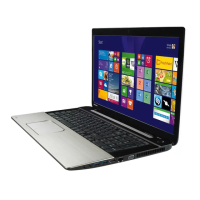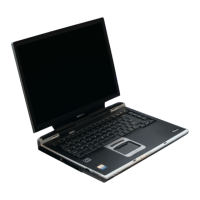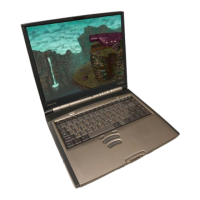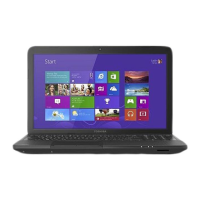Do you have a question about the Toshiba S70-B and is the answer not in the manual?
Contains copyright, legal disclaimers, and trademark information.
Details FCC, EU, Canadian, and other regulatory compliance information.
Specific regulations applicable to Canada.
Guidance on proper disposal of the computer and its batteries.
Information regarding the EU's REACH chemical regulation.
Licensing information for video standards used in the product.
Information about the computer's ENERGY STAR compliance and energy efficiency.
Precautions for safe operation of the optical disc drive.
Important safety and handling guidelines for computer use.
Precautions against physical stress, heat, and impact damage during use.
Instructions for cleaning and safely moving the computer.
Explanation of safety icons used in the manual.
Lists necessary hardware and documentation for setup.
Explains formatting and symbols used in the manual.
Basic steps and advice for initial computer usage.
Detailed instructions for connecting the AC adaptor for power.
Guidance on how to open the computer's display panel.
Steps to turn on the computer and begin initial setup.
Overview of Windows features like Start screen, Taskbar, and Charms.
Procedures for shutting down or placing the computer in Sleep/Hibernation mode.
Steps to restart and explanations of Sleep Mode functionality.
Discusses limitations, benefits, and execution of Sleep Mode.
Details on Hibernation Mode, its benefits, and starting it.
Configuration for automatic hibernation and data saving procedures.
Identifies components on the front of the computer with the display closed.
Identifies ports and slots on the left side of the computer.
Identifies ports and connectors on the right side of the computer.
Identifies the battery pack and cooling vents on the back/underside.
Identifies components visible when the display is open.
Identifies components on the top side, including webcam and microphone.
Details about the display screen, hinges, power button, and keyboard.
Description of internal components like CPU and Hard Disk Drive.
Features for optimizing power consumption with Intel graphics.
Features for optimizing power consumption with AMD graphics.
Explains LED indicators for power and battery status.
Explains various touch pad gestures like tap, scroll, and swipe.
Details on keyboard keys, CAPS LOCK, and NUM LOCK indicators.
Explains special and standard modes for function keys (F1-F12).
Information on Windows keys and generating ASCII characters.
Information on DVD and Blu-ray drives and supported formats.
Step-by-step guide on loading and removing discs.
Types of writable discs and precautions for writing data.
Notes and limitations for using CyberLink PowerDVD software.
Notes and limitations for using the TOSHIBA Blu-ray Disc Player.
Information on 3D playback features and safety.
Explains battery types, usage, recharging, and handling.
Details on the RTC function and its power source.
Safety precautions for handling and using the battery pack.
Procedures for charging the battery pack.
Methods to monitor and extend battery life.
Information on battery duration and tips to maximize its lifespan.
Step-by-step guide for removing and installing the battery pack.
Instructions on connecting to a Local Area Network.
Information on memory media slots and types.
Precautions for handling and formatting memory cards.
Steps to safely remove memory media from the computer.
How to connect external displays like monitors via RGB or HDMI.
Connecting devices via HDMI and configuring display settings.
Using wireless technology to connect to external displays.
Managing display configurations and securing the computer.
Information on optional accessories like AC adaptors and battery packs.
Controls for audio volume, microphone level, and video settings.
Utility for adjusting display settings like text size and resolution.
Utility to set and manage user and supervisor passwords.
Customizes hardware settings and peripherals.
Software for playing DVD Video content.
Software for playing Blu-ray Disc content.
Utility for viewing and changing BIOS settings.
Manages power consumption and battery life.
Manages and shares multimedia content.
Performs features using specific keys or FN key combinations.
Searches for software updates and system alerts.
Monitors system functions like power, battery, and cooling.
Upscales videos for Windows Media Player.
Unique or advanced features enhancing computer usability.
Explains how to use Sleep and Hibernation modes for power saving.
Provides two levels of password security: User and Supervisor.
Steps to set, delete, or change user passwords.
Setting supervisor passwords and starting the computer with a password.
Tabs within System Settings for configuring various computer aspects.
Using USB ports for charging devices, including Sleep and Charge.
Rapid USB charging and disabling features based on battery level.
Monitors system functions like power, battery, and cooling.
Creating recovery media and restoring the system.
Steps to restore the system using created media or the recovery partition.
Guidelines for diagnosing and resolving problems.
Questions to ask and observations to make when troubleshooting.
Troubleshooting issues related to software and hardware components.
Steps to take when the computer or programs stop responding.
Loading advanced options like BIOS utility or recovery options.
Discusses common problems related to hardware and peripherals.
Resolving overheating shutdowns and AC power connection problems.
Troubleshooting issues related to the computer's battery.
Resolving issues with the BIOS date/time and keyboard functionality.
Troubleshooting no display or markings on the screen.
Resolving problems with HDD access and optical disc drive functionality.
Troubleshooting errors related to memory media cards.
Resolving issues with the Touch Pad and USB mouse.
Troubleshooting USB devices, Sleep and Charge, and Wakeup functions.
Resolving issues with sound output and external monitor connections.
Troubleshooting LAN connection and Wireless LAN access.
Troubleshooting issues with accessing Bluetooth devices.
Information on how to get technical assistance from TOSHIBA.
Summarizes technical specifications including physical dimensions and environmental requirements.
Details the AC adaptor and computer power requirements.
Pin configuration details for the external RGB monitor port.
Information on AC power cords, connectors, and certification agencies.
Details on wireless technology interoperability and health considerations.
Regulations for radio frequency use in Europe and other regions.
Compliance information for Canadian (IC) and US (FCC) regulations.
Specific usage instructions and notices for Taiwan and Japan.
Visual indications for Wireless LAN and Bluetooth functions.
Lists authorized wireless devices and restrictions.
Explanations of legal terms related to CPU, Memory, and Battery Life.
Information on 64-bit compatibility and main system memory usage.
Factors affecting battery life and definitions of HDD capacity.
Information on LCD deterioration, GPU performance, and Wireless LAN speed.
Details on copy protection and VCCI Class B compliance for Japan.
License terms for the OpenSSL Toolkit software.
License terms for the FreeType Project software.
| RAM | 8 GB |
|---|---|
| Storage | 1 TB HDD |
| Display Size | 17.3 inches |
| Resolution | 1600 x 900 |
| Operating System | Windows 8.1 |
| Battery Life | Up to 6 hours |
| Battery | 4-cell Lithium-ion |











